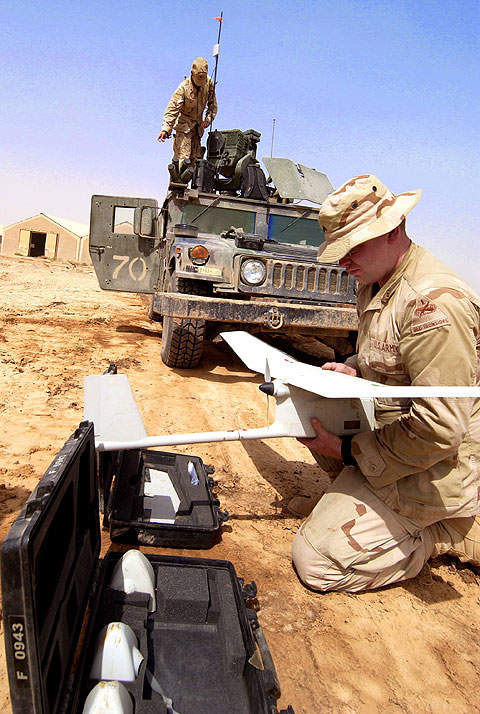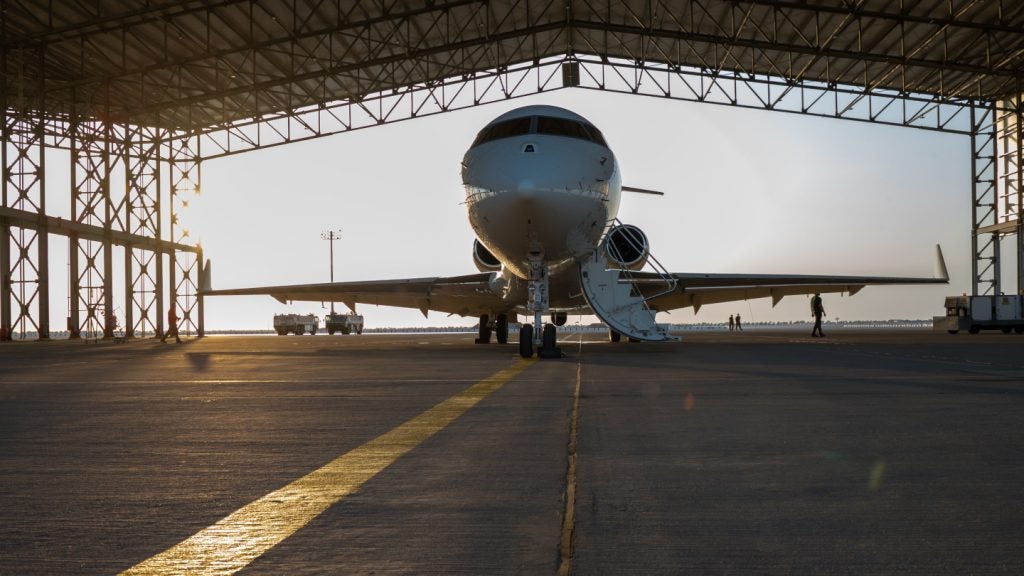The RQ-11B Raven (Raven B) is a lightweight and low-altitude, remote-controlled, man-portable unmanned air vehicle (UAV) system designed and developed for the US Armed Forces by AeroVironment, a company based in the US.
The UAV performs intelligence, surveillance, target acquisition and reconnaissance (ISTAR) operations.
The vehicle captures and transmits medium-resolution imagery to a ground control unit (GCU) through a digital data link (DDL).
The UAV is hand-launched, which lands safely through auto-piloting without the need for landing gear and prepared landing strips. The UAV completed its maiden flight in October 2001 and entered service in May 2003.
Flying at an altitude of 100ft to 500ft, the Raven B provides real-time colour or infra-red imagery to the ground control and remote viewing units. It assists in performing surveillance and target acquisition over a large area, while providing infra-red laser rays illuminated or emitted by the ground targets.
The RQ-11B Raven received a military-type classification certificate from the Netherlands Military Aviation Authority in November 2009.
RQ-11B Raven UAV orders and deliveries
AeroVironment won the small unmanned aerial vehicles (SUAV) programme competition organised by the US Army in October 2005. The winning contract included the supply of 2,182 Raven systems along with the ground control system and three air vehicles.
In 2010, the contract was increased to 2,358 Raven systems. The contract also includes upgrades for system improvements over the life of the programme.
Approximately 70% of the Raven systems were delivered to the US Army by April 2011. Deliveries under the contract were concluded in 2015.
In September 2007, about 12 Raven B systems were procured by the Royal Danish Army, of which three were delivered to Huntsmen Corps and the remaining were deployed at the artillery centre for training purposes. Around 72 Raven B systems were acquired by the Netherlands Ministry of Defence for $23.74m.
The US Army ordered 50 RQ-11B Raven systems in February 2009 as part of the $16.8m contract. The contract also includes supplying spare parts and digital data link (DDL) retrofit systems for 206 existing Raven systems. Deliveries commenced in October 2009.
The US Army and Marine Corps placed a $23.9m order with AeroVironment in December 2009 for upgrading the existing systems with digital Raven systems and kits.
In February 2010, the US Department of Defence awarded a $37.8m contract to AeroVironment to design and develop advanced digital Ravens, retrofit kits and spare parts, and provide repair and training services to the US Army and the US Marine Corps (USMC). The advanced digital Raven system offers higher communication security through signal encryption.
The US Army awarded a $3.4m contract to AeroVironment for the supply of RQ-11B Raven UAVs to the Spanish Ministry of Defense in August 2015. A $47m contract was also awarded for RQ-11B Raven and RQ-20A Puma AEs in the same month.
In October 2015, AeroVironment secured an $18.5m order from the US Army for the supply of Raven systems, spare parts, and logistics services for seven allied nations, under the foreign military sales (FMS) programme.
The company was awarded with a $13m contract by the US Air Force in September 2018, for the delivery of RQ-11B Raven systems to support the countries in Central America, South America, and the Caribbean.
Deliveries of upgraded digital Raven UAVs
In March 2010, AeroVironment received a $6.7m contract from the US Army for the supply of 51 digital Raven systems, spare packages, and logistics support services. In the following month, AeroVironment received another order worth $12.3m for providing 216 retrofit kits to upgrade the existing analogue Raven systems with a new digital data link.
In May 2010, AeroVironment was awarded an $11.2m contract by the US Army to supply 63 new digital Raven UASs.
In December 2010, the company received a $4.9m contract from the Norwegian Defence Logistics Organisation for small raven UAS, spares, training services and logistics support. Deliveries under the contract began in 2011.
In December 2010, the US Army awarded a $46.2m contract to AeroVironment for the supply of 123 advanced digital Raven systems, initial spare packages and 186 digital retrofit kits to the USMC. The contract also includes the supply of 339 digital retrofit kits to the US Army.
RQ-11B Raven design
The Raven B has been designed for both military and commercial applications. The aircraft weighs around 4.2lb (1.9kg). It is an advanced small unmanned aircraft system (SUAS) used for force protection and to convoy security, battle damage assessment for light infantry, dismounted warfighter.
About 3,000 Ravens were deployed by the US Force for military operations in urban terrain (MOUT) missions.
The UAV is incorporated with colour video electro-optic camera in the nose section to capture imagery of the battlefield. It is also fitted with an infra-red night vision camera and side-mounted infra-red camera. It offers medium-resolution imagery of the field as the camera does not have a zooming option.
Raven B UAV development
The RQ-11B is an upgraded version of the RQ-11A Raven system, which is no longer in production. The RQ-11B was developed as part of the US Army’s small unmanned air vehicle (SUAV) programme in 2005.
The full-rate production of the UAV began in 2006 and continued for five years, providing continuous system improvements over the life of the programme.
More than 13,000 Raven aircraft have been delivered to different countries worldwide. The DDL version has enhanced the endurance of the vehicle.
Raven B features
The entire Raven B system encompasses three aircraft, a ground control unit (GCU), a remote video terminal unit, spare batteries, a charger, and support equipment. It also has an autoland feature and an interoperable system interface unit.
The UAV is fully equipped with an automatic launch and recovery (ALR) system, which aids automatic safe landing during communication failure with the ground control station.
RQ-11B UAV navigation
The RQ-11B can be controlled either manually from the ground control station or through the autonomous mode. The Raven B system provides fully automated take-off and landing, even in adverse weather conditions using advanced avionics and a precision global positioning system (GPS) system.
Electro-optic (EO) and infra-red sensors are installed in the Raven B system. The EO sensor converts light rays into electronic signals for capturing images, real-time data and videos.
RQ-11B Raven engines
The RQ-11B Raven is powered by a single Aveox 27/26/7-AV electric motor. The engine is manufactured by US-based Aveox.
Each engine features an integrated starter or generators, flight surface actuation systems, integrated gearboxes, shafts, cooling fans and pumps.
The ground control unit (GCU) is a compact and lightweight system, which displays real-time videos or images captured by the vehicle’s payload cameras.
The processing, retrieving and storing of the real-time data provided by the UAV is carried out at the GCU. It also plays back videos for target evaluation and alleviates retransmission of videos and meta data to the operations network.
The GCU can be operated as a remote video terminal (RVT) when implanted at remote locations. It also enables the command centres to view and analyse the data. The ground control unit can be easily assembled or disassembled in just two minutes.
RQ-11B UAV performance
The UAV can fly at a maximum altitude of 500ft (152m). The maximum cruising speed of the aircraft varies between 32km/h and 81km/h. The range and service ceiling of the aircraft are 12km and 4,500m respectively. Its maximum endurance is 90 minutes.
The Global Unmanned Aerial Vehicles (UAV) Market 2011-2021
This project forms part of our recent analysis and forecasts of the global Unmanned Aerial Vehicles (UAV) market available from our business information platform Strategic Defence Intelligence. For more information click here or contact us: EMEA: +44 20 7936 6783; Americas: +1 415 439 4914; Asia Pacific: +61 2 9947 9709 or via email.













